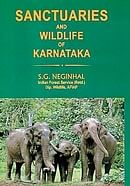
In the early 70s, there was a lively debate going on among policy makers in Delhi about the desirability of creating a Wildlife Service for protecting the dwindling wildlife of our country. It was finally decided not to create a new service as it was rightly felt that the wildlife officer would come in continuous conflict with the territorial forester in-charge of the area. It was decided that within the Forest Service, there would be a separate cadre specially trained for managing our wild animals.
Neginhal was one of the first members of this Wildlife Wing of the Forest Service. He has been passionately fond of wildlife photography and his recent book about Sanctuaries and Wildlife in Karnataka is a welcome addition to the literature on the subject.
The 230-page book, with incredible photographs on every page gives you a most useful/helpful account of the 29 protected areas of Karnataka, with every detail about its geographical area, its animals and birds, and advice about whom to contact for reservations, accommodation, and other details which visitors are happy to have in advance.
One of the complaints about government officials is that they don’t leave their desks, and are not aware of what is happening in the field. Neginhal loves the outdoors, and he was the first to draw attention to the presence of spotfilled pelecons and painted starks in Kokrebellur, and to the protection which these birds receive from the villagers and the need to conserve the surround habitat essential for these birds. The pelecons are an endangered species and their future is causing concern world wide. Read about this exciting discovery in his own ‘excited’ words on page 176.
We who stay in Koramangala have to be thankful to Neginhal for his close connection with trees as well. As Deputy Conservator of Forests (Urban) in 1982, he was responsible for the roadside planting of trees (Rain trees, Jacarandas, Tulip trees, Magnolias, Honges) which are still a great asset of this layout.
You will enjoy Neginhal’s book, and learn a great deal about the most beautiful areas of Karnataka and you may be surprised about how much natural area still remains — for us to preserve and enjoy.